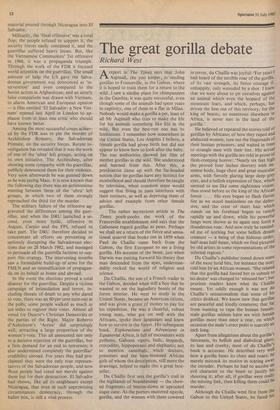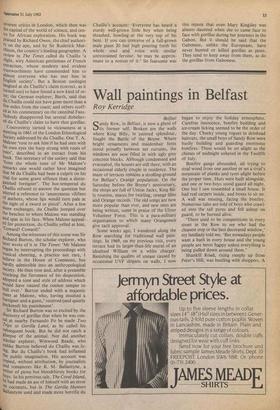The great gorilla debate
Richard West
Areport in The Times says that John Aspinall, the zoo keeper, is sending gorillas to Franceville, in the Gabon, where it is hoped to train them for a return to the wild. I saw a similar place for chimpanzees in the Gambia; it was quite successful, even though some of the animals had spent years in captivity, one of them in a flat in Milan. Nobody would make a gorilla a pet, least of all Mr Aspinall who tries to make the life for his animals something like life in the wild. But even the best-run zoo has its limitations. I remember how somewhere in the United States, Los Angeles I believe, a female gorilla had given birth but did not appear to know how to look after the baby. The zoo authorities showed her film of mother gorillas in the wild. She understood and learned from this. After this, a psychiatrist came up with the fat-headed notion that no gorillas have any instinct for motherhood and should therefore be taught by television, when common sense would suggest that living in zoos interferes with their instincts, as well as depriving them of advice and example from other female gorillas.
The rather mysterious article in The Times pooh-poohs the work of the Franceville establishment and says that the Gabonese regard gorillas as pests. Perhaps we shall see a return of the fierce and sensa- tional quarrel that broke out in 1859 when Paul du Chaillu came back from the Gabon, the first European to see a living gorilla. His account of the beast, just when Darwin was putting forward his theory that man descended from the apes, understan- dably rocked the world of religion and science.
Du Chaillu, the son of a French trader in the Gabon, decided when still a boy that he wanted to see the legendary beasts of the forest interior. He went to study in the United States, became an American citizen, and was given a grant of money to pay for his expedition. He was a cheerful, robust young man, who got on well with the Africans, spoke their languages and knew how to survive in the forest. His subsequent book, Explorations and Adventures in Equatorial Africa, is full of encounters with pythons, Gaboon vipers, bulls, leopards, crocodiles, hippopotami and elephants; not to mention cannibals, witch doctors, poisoners and the bare-breasted African girls of whom the description, still more the drawings, helped to make this a great best- seller.
Du Chaillu first sees the gorilla's trail in the highlands of Ntambounay — the chew- ed fragments of beaten-down or uprooted sugar cane. As the porters muttered nguyla, gorilla, and the women with them cowered
in terror, du Chaillu was joyful: 'For years! had heard of the terrible roar of the gorilla, of its vast strength, its fierce courage if, unhappily, only wounded by a shot. I knew that we were about to pit ourselves against an animal which even the leopard of the mountain fears, and which, perhaps, has driven the lion out of this territory; for the king of beasts, so numerous elsewhere in Africa, is never met in the land of the gorilla.' He believed or repeated the stories told of gorillas by Africans; of how they raped and abducted women, tore out the fingernails of their human prisoners, and waited in trees to strangle men with their feet. His actual meetings with the gorilla are told in prose of flesh-creeping horror: 'Nearly six feet high (he proved four inches shorter) with im- mense body, huge chest and great muscular arms, with fiercely glaring large deep greY eyes, and a hellish expression of face, which seemed to me like some nightmare vision: thus stood before us the king of the African forest .... His eyes began to flash fiercer fire as we stood motionless on the defen- sive, and the crest of short hair which stands on his forehead began to twitch rapidly up and down, while his powerful fangs were shown as he again sent forth a thunderous roar. And now truly he remind- ed me of nothing but some hellish dream creature — a being of that hideous order, half-man half-beast, which we find pictured by old artists in some representations of the infernal regions.'
Du Chaillu's publisher toned down some of the most lurid bits, for instance the story told him by an African woman. 'She related that the gorilla had forced her to submit to his desire' was changed to 'misused her'; but prurient readers knew what du Chaffin meant. Yet oddly enough it was not du Chaillu's sensationalism that some of his critics disliked. We know now that gorillas are peaceful and kindly creatures; that far from wanting to rape the human female, male gorillas seldom have sex with female gorillas more than once a year, on which occasion the male's erect penis is scarcely an inch long. Apart from allegations about the gorilla's fierceness, its hellish and diabolical glare, its lust and cruelty, most of du Chaillu s book is accurate. He described very Welt how a gorilla beats its chest and roars; he merely mistook its motive in scaring away the intruder. Perhaps he had to ascribe an evil character to the beast to justify his shooting it; after all, if gorillas were reallY the missing link, then killing them could he murder.
Although du Chaillu went first from the Gabon to the United States, he faced his
severest critics in London, which then was the capital of the world of science, and cen- tre for African exploration. His book was Praised by Richard Owen, the chief authori- tY on the ape, and by Sir Roderick Mur- chison, the country's leading geographer. A review in The Times called du Chaillu 'a Slight, wiry American gentleman of French extraction, whose modesty and evident trustworthiness have commended him to almost everyone who has met him in English society'. But a Boston zoologist laughed at du Chaillu's claim (correct, as it turned out) to have found a new kind of ot- ter; the German explorer, Barth, said that du Chaillu could not have gone more than a few miles from the coast; and others scoff- ed at his commentary on the cannibal Fans. Nobody disapproved but several disbeliev- ed du Chaillu's claim to have shot gorillas. Controversy turned to viciousness at a Meeting in 1861 of the London Ethnological Society addressed by du Chaillu. One T. A. Malone 'rose to ask him if he had seen with his own eyes the harp strung with roots of trees', described in an extract from his ook. The secretary of the society said that from the whole tone of Mr Malone's remarks one would rather have imagined that M du Chaillu had been a culprit on his trial for some grave offence than a distin- gUished foreigner'. The hot-tempered du Chaillu refused to answer the question but uttered a reference to 'anonymous vilifiers Of authors, whose lips would turn pale at the sight of a sword or pistol'. After a few Inore exchanges, du Chaillu jumped over the benches to where Malone was standing and spat in his face. When Malone appeal- ed for protection, du Chaillu yelled at him, Coward! Coward!'
.Among the witnesses of this scene was Sir Itichard Burton, the scholar explorer, who later wrote of it in The Times: 'Mr Malone began by interrupting the proceedings with ironical cheering, a practice not rare, I believe in the House of Commons, but hardly admissible into an anthropological society. He then rose and, after a preamble touching the fierceness of his disposition, adopted a tone and style of address which would have caused the coolest temper to boil over.' Burton ended with a majestic sneer at Malone, who, having insulted a foreigner and a guest,' received (and quietly Pocketed) his punishment'. Sir Richard Burton was so excited'by the discovery of gorillas that when he was con- sul at nearby Fernando Po he made Two TriPs to Gorilla Land, as he called his subsequent book. But he did not catch a glirnpse of the animal. Nor did another seholar explorer, Winwood Reade, who Unlike Burton believed du Chaillu was ly- ing. But du Chaillu's book had inflamed the public imagination. His account was Copied, without attribution, by journalists and romancers like R. M. Ballantyne, a writer of pious but bloodthirsty books for bioYs. In his previous tale, The Coral Island, 'le had made an ass of himself with an error 211 coconuts, but in The Gorilla Hunters tiallantyne used and made more horrific du
Chaillu's account: 'Everyone has heard a sturdy well-grown little boy when being thrashed, howling at the very top of his bent. If you can conceive of a full-grown male giant 20 feet high pouring forth his whole soul and voice with similar unrestrained fervour, he may be approx- imate to a notion of it.' So fearsome was this repute that even Mary Kingsley was almost daunted when she to came face to face with gorillas during her journeys in the Gabon. But it should be said that the Gabonese, unlike the Europeans, have never hunted or killed gorillas as pests. They tend to keep away from them, as do the gorillas from Gabonese.







































 Previous page
Previous page